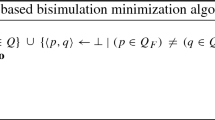Abstract
We here study previous results due to Hopcroft and Almeida et al. to propose an incremental split-based deterministic automata minimization algorithm whose average running-time does not depend on the size of the alphabet. The experimentation carried out shows that our proposal outperforms the algorithms studied whenever the automata have more than a (quite small) number of states and symbols.








Similar content being viewed by others
Notes
We note that, in order to obtain an easier-to-follow example of run, in line 12 of Algorithm 3.2 we stack the symbols of the alphabet in reverse order.
According previous personal communication with the authors, the dataset was slightly modified in order to provide to each automaton in the corpus a uniformly-chosen set of final states.
References
Hopcroft, J.E., Ullman, J.D.: Introduction to Automata Theory, Languages and Computation. Addison-Wesley Publishing Company (1979)
Watson, B.W., Daciuk, J.: An efficient incremental DFA minimization algorithm. Nat. Lang. Eng. 9(1), 49–64 (2003)
Almeida, M., Moreira, N., Reis, R.: Incremental DFA minimisation. In: Domaratzki, M., Salomaa, K. (eds.) CIAA, of Lecture Notes in Computer Science, vol. 6482, pp 39–48. Springer (2010)
Hopcroft, J.E.: An \(n\cdot \log n\) algorithm for minimizing states in a finite automaton. Technical report, Stanford, University, Stanford (1971)
Moore, E.F.: Gedanken experiments on sequential machines. In: Shannon, C.E., Mc-Carthy, J. (eds.) Automata Studies. Princeton Universty Press, Princeton (1956)
Berstel, J., Boasson, L., Carton, O., Fagnot, I.: Automata: from Mathematics to Applications, chapter Minimization of automata. European Mathematical Society. (arXiv:1010.5318v3.) To appear.
David, J.: Average complexity of Moore’s and Hopcroft’s algorithms. Theor. Comput. Sci. 417, 50–65 (2012)
Almeida, M., Moreira, N., Reis, R.: Aspects of enumeration and generation with a string automata representation. In: Leung, H., Pighizzini, G. (eds.) DCFS, pp 58–69. New Mexico State University, Las Cruces (2006)
Gries, D.: Describing an algorithm by Hopcroft. Acta Informatica 2, 97–109 (1973)
Aho, A., Hopcroft, J.E., Ullman, J.D.: The Design and Analysis of Computer Algorithms. Addison-Wesley Publishing Company (1974)
Blum, N.: A \(\mathcal {O}(n\log n)\) implementation of the standard method for minimizing n-state finite automata. Inf. Process. Lett. 57, 65–69 (1996)
Knuutila, T.: Re-describing an algorithm by Hopcroft. Theor. Comput. Sci. 250, 333–363 (2001)
Veanes, M.: Minimization of symbolic automata. Technical report, Microsoft Research, MSR-TR-2013-48 (2013)
Lothaire, M.: Applied Combinatorics on Words chap. 1. Cambridge University Press, Cambridge (2005)
Author information
Authors and Affiliations
Corresponding author
Rights and permissions
About this article
Cite this article
García, P., de Parga, M.V., Velasco, J.A. et al. A Split-Based Incremental Deterministic Automata Minimization Algorithm. Theory Comput Syst 57, 319–336 (2015). https://doi.org/10.1007/s00224-014-9588-y
Published:
Issue Date:
DOI: https://doi.org/10.1007/s00224-014-9588-y




